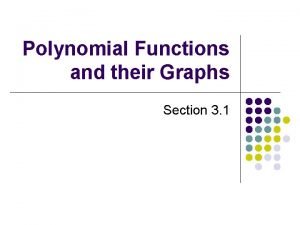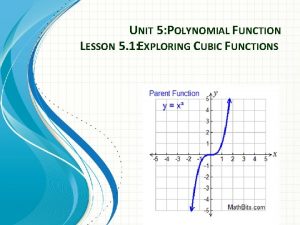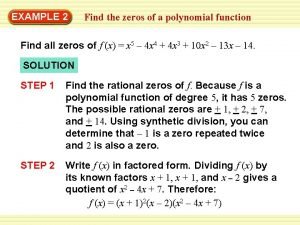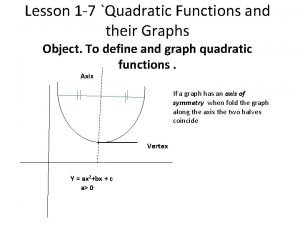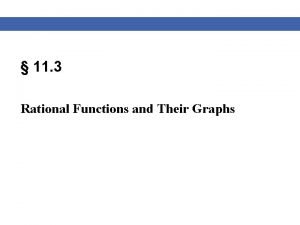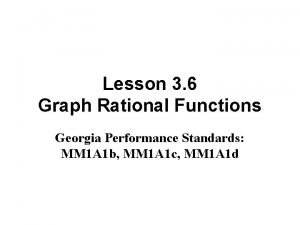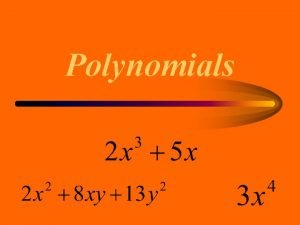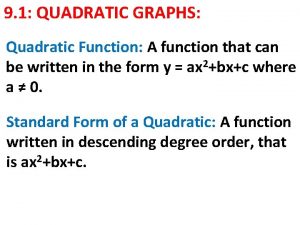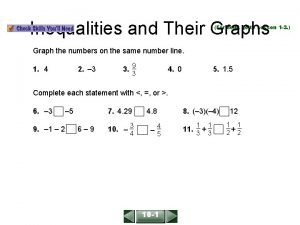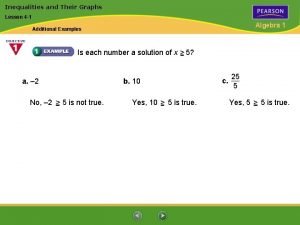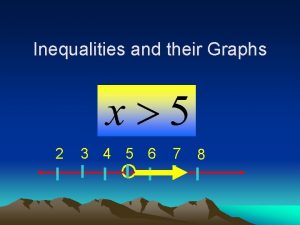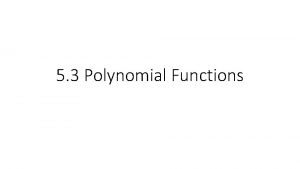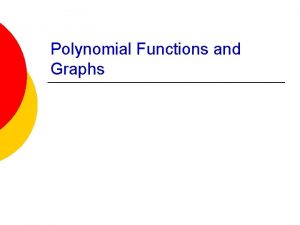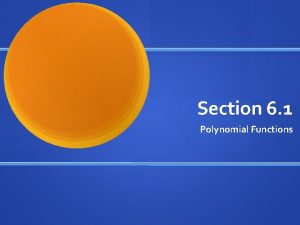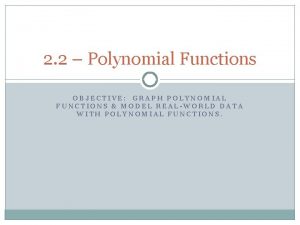Section 3 2 Polynomial Functions and Their Graphs































- Slides: 31

Section 3. 2 Polynomial Functions and Their Graphs

Smooth, Continuous Graphs

Polynomial functions of degree 2 or higher have graphs that are smooth and continuous. By smooth, we mean that the graphs contain only rounded curves with no sharp corners. By continuous, we mean that the graphs have no breaks and can be drawn without lifting your pencil from the rectangular coordinate system.

Notice the breaks and lack of smooth curves.

End Behavior of Polynomial Functions


ial m o n oly with d. p s e h gre rap ach en e g d e Odd ons hav ior at e l v ti func ite beha lynomia ith the s o w oppo degree p graphs nd. e e Even ons hav at each r ti func behavio e sam

Example Use the Leading Coefficient Test to determine the end behavior of the graph of f(x)= - 3 x 3 - 4 x + 7

Example Use the Leading Coefficient Test to determine the end behavior of the graph of f(x)= -. 08 x 4 - 9 x 3+7 x 2+4 x + 7 This is the graph that you get with the standard viewing window. How do you know that you need to change the window to see the end behavior of the function? What viewing window will allow you to see the end behavior?

Zeros of Polynomial Functions

If f is a polynomial function, then the values of x for which f(x) is equal to 0 are called the zeros of f. These values of x are the roots, or solutions, of the polynomial equation f(x)=0. Each real root of the polynomial equation appears as an x-intercept of the graph of the polynomial function.

Find all zeros of f(x)= x 3+4 x 2 - 3 x - 12

Example Find all zeros of x 3+2 x 2 - 4 x-8=0

Multiplicity of x-Intercepts



Graphing Calculator- Finding the Zeros x 3+2 x 2 - 4 x-8=0 One zero of the function One of the zeros Other zero The other zero The x-intercepts are the zeros of the function. To find the zeros, press 2 nd Trace then #2. The zero -2 has multiplicity of 2.

Example Find the zeros of f(x)=(x- 3)2(x-1)3 and give the multiplicity of each zero. State whether the graph crosses the x-axis or touches the x-axis and turns around at each zero. Continued on the next slide.

Example Now graph this function on your calculator. f(x)=(x- 3)2(x-1)3

The Intermediate Value Theorem


Show that the function y=x 3 - x+5 has a zero between - 2 and -1.

Example Show that the polynomial function f(x)=x 3 - 2 x+9 has a real zero between - 3 and - 2.

Turning Points of Polynomial functions

The graph of f(x)=x 5 - 6 x 3+8 x+1 is shown below. The graph has four smooth turning points. The polynomial is of degree 5. Notice that the graph has four turning points. In general, if the function is a polynomial function of degree n, then the graph has at most n-1 turning points.

A Strategy for Graphing Polynomial Functions


Example Graph f(x)=x 4 - 4 x 2 using what you have learned in this section.

Example Graph f(x)=x 3 - 9 x 2 using what you have learned in this section.

Use the Leading Coefficient Test to determine the end behavior of the graph of the polynomial function f(x)=x 3 - 9 x 2 +27 (a) (b) (c) (d)

State whether the graph crosses the x-axis, or touches the x-axis and turns around at the zeros of 1, and - 3. f(x)=(x-1)2(x+3)3 (a) (b) (c) (d)
 Which two graphs are graphs of polynomial functions?
Which two graphs are graphs of polynomial functions? Types of polynomials based on degree
Types of polynomials based on degree Polynomial functions and their graphs
Polynomial functions and their graphs Polynomial functions and their graphs
Polynomial functions and their graphs Practice a investigating graphs of polynomial functions
Practice a investigating graphs of polynomial functions Investigating graphs of polynomial functions
Investigating graphs of polynomial functions 6-7 investigating graphs of polynomial functions
6-7 investigating graphs of polynomial functions 5-4 analyzing graphs of polynomial functions
5-4 analyzing graphs of polynomial functions 6-7 investigating graphs of polynomial functions
6-7 investigating graphs of polynomial functions Unit 5 polynomial functions
Unit 5 polynomial functions 5-4 practice analyzing graphs of polynomial functions
5-4 practice analyzing graphs of polynomial functions Unit 3 lesson 3 rational functions and their graphs
Unit 3 lesson 3 rational functions and their graphs Quadratic functions and their graphs
Quadratic functions and their graphs 8-3 rational functions and their graphs
8-3 rational functions and their graphs Chapter 1 functions and their graphs
Chapter 1 functions and their graphs Rational functions and their graphs
Rational functions and their graphs Common functions and their graphs
Common functions and their graphs Exponential functions and their graphs
Exponential functions and their graphs Chapter 2 functions and their graphs answers
Chapter 2 functions and their graphs answers Rational functions and their graphs
Rational functions and their graphs Lesson 3: rational functions and their graphs
Lesson 3: rational functions and their graphs State bugs in software testing
State bugs in software testing Graphs that enlighten and graphs that deceive
Graphs that enlighten and graphs that deceive Speed and velocity
Speed and velocity Types of polynomial graphs
Types of polynomial graphs Matplotlib inline
Matplotlib inline How to divide a polynomial by another polynomial
How to divide a polynomial by another polynomial Quadratic graphs and their properties
Quadratic graphs and their properties Expander graphs and their applications
Expander graphs and their applications Lesson 3-1 inequalities and their solutions
Lesson 3-1 inequalities and their solutions 3-1 inequalities and their graphs
3-1 inequalities and their graphs 3-1 inequalities and their graphs answer key
3-1 inequalities and their graphs answer key

